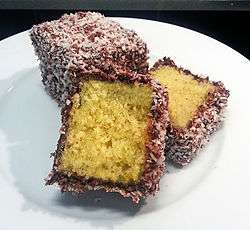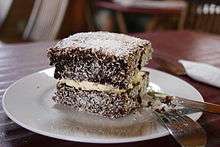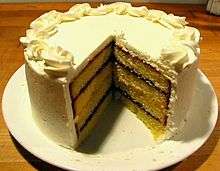Lamington
A lamington is an Australian cake made from squares of butter cake or sponge cake coated in an outer layer of chocolate sauce and rolled in desiccated coconut. The thin mixture is absorbed into the outside of the sponge cake and left to set, giving the cake a distinctive texture. A common variation has a layer of cream or strawberry jam between two lamington halves.[1][2]
 Lamington cut open | |
| Type | Sponge cake |
|---|---|
| Place of origin | Australia |
| Region or state | Queensland |
| Main ingredients | Cake, Chocolate sauce, Desiccated coconut |
Origins
Maurice French, an emeritus professor of history at the University of Southern Queensland, who has examined the question in depth,[3] believes that lamingtons were named after either Lord Lamington, who served as Governor of Queensland from 1896 to 1901, or his wife, Lady Lamington.[4][5] Most sources incline to the former.[6][7][8] The earliest known reference to the naming of the lamington, from June 1927, links the cake to Lord Lamington.[9]
The identity of the recipe's inventor has also been debated. Most stories attribute its creation to Lord Lamington's chef, the French-born Armand Galland, who was called upon at short notice to feed unexpected guests. Using only the limited ingredients available, Galland cut up some left-over French vanilla sponge cake baked the day before, dipped the slices in chocolate and set them in coconut. Impressed by Galland's creation, Lamington's guests were said to have later asked for the recipe. This version of events is supported by Lady Lamington's memoirs.[10] Coconut was not widely used in European cooking at that time, but was known to Galland, whose wife was from Tahiti, where coconut was a common ingredient.
One account suggests that the lamington was first served in Toowoomba, when Lord Lamington took his entourage to Harlaxton House to escape the steamy heat of Brisbane,[11] whereas another claims that it was created by Galland at Queensland's Government House in Brisbane during the busy period leading up to Federation in 1901. A further alternative claim is that Lord Lamington's cook, presumably Galland, accidentally dropped a block of sponge cake into a dish of chocolate. It was later discovered that desiccated coconut, sprinkled over the top, made the cakes more appealing.[12]
The first known mention of "Lamington cake" appears in an 1896 newspaper account of a "Lamington Function" at Laidley in Queensland. The event was in honour of Lord Lamington (although it appears he did not attend) and also featured "Lamington Tea", "Lamington Soup" etc, so, in the absence of any description of the cake, the name of the cake might signify nothing more than the name of the event.[13] A 1900 recipe for Lamington Cakes has been found in the Queensland Country Life newspaper.[14] While the recipe originated in Queensland, it spread quickly, appearing in a Sydney newspaper in 1901[15] and a New Zealand newspaper in 1902.[16] However, none of these recipes indicate the creator of the recipe nor the reason for its name.
2014 April Fools' Day prank by The Guardian
Due to an April Fools' Day prank in The Guardian, on 1 April 2014, written by Olaf Priol (an anagram of April Fool), some people[17][18][19] falsely believed that the lamington was originally a New Zealand cake known as a "Wellington", which existed before the Australian lamington.[20][21] A later article in The Guardian commented that this prank had even fooled Wikipedia.[22]
Modern day

Lamingtons remain a popular treat across Australia and New Zealand, and 21 July was designated as National Lamington Day in Australia.[23][2] Lamingtons are often sold at fundraisers for schools or charity groups, known as "lamington drives".[24] Some Australians shorten the name to "Lammo" (singular) or "Lammos" (plural).[25]
Variants
A similar but smaller-sized confection is known in South Africa as ystervarkies (little porcupines), while in the U.S. city of Cleveland, they are called coconut bars.[4] Another similar dessert known as čupavci or coconut cubes is also eaten in Slovenia, Serbia, Bosnia and Herzegovina, Croatia, Hungary and Romania. The tiny British Overseas Territory, St Helena Island in the South Atlantic Ocean has a similar variation called Coconut Fingers, made traditionally for special occasions such as weddings and birthdays.[26]
Awards
In 2009, as part of the Q150 celebrations, the lamington was announced as one of the Q150 Icons of Queensland for its role as an iconic "innovation and invention".[28]
References
- Michael Symons (1984). One Continuous Picnic: A History of Eating in Australia. Penguin Books Australia. ISBN 978-0-14-007167-2. Archived from the original on 14 March 2017.
- Wong, Jennifer (24 January 2019). "Everything you need to know about lamingtons, the most Australian cake". ABC Life. Australian Broadcasting Corporation. Retrieved 28 January 2019.
- French, Maurice (2013). The Lamington Enigma: A Survey of the Evidence. Tabletop Publishing. ISBN 978-0-9874322-0-9. Archived from the original on 15 March 2017. Retrieved 23 May 2018.
- Veenhuyzen, Max (15 May 2014). "Lamingtons – provenance unproven but tastiness unquestioned". Great Australian dishes. The Guardian. Guardian Media Group. eISSN 1756-3224. Archived from the original on 28 April 2016. Retrieved 21 April 2016.
- Martell, Ally (25 June 2013). "A slice of the action - the lamington demands recognition". The Australian. News Corp Australia. ISSN 1038-8761. Archived from the original on 16 October 2016. Retrieved 10 September 2016.
- Goldstein, Darra, ed. (2015). The Oxford Companion to Sugar and Sweets. Oxford University Press. p. 34. ISBN 978-0-19-931339-6. Archived from the original on 15 March 2017. Retrieved 23 May 2018.
- Davidson, Alan (2014). Jaine, Tom (ed.). The Oxford Companion to Food (3rd ed.). Oxford University Press. p. 456. ISBN 978-0-19-104072-6. Archived from the original on 14 March 2017. Retrieved 23 May 2018.
- Santich, Barbara (2012). Bold Palates: Australia's Gastronomic Heritage. Adelaide: Wakefield Press. p. 203. ISBN 978-1-74305-094-1. Archived from the original on 14 March 2017. Retrieved 23 May 2018.
- "Some Special Recipes". Women's World. The Sydney Mail. John Fairfax and Sons. 29 June 1927. pp. 37–38. Retrieved 1 February 2015 – via Trove.
- Marriner, Cosima (6 June 2009). "Galland attempt to please a Lady takes the Cake". The Sydney Morning Herald. Fairfax Media. ISSN 0312-6315. Archived from the original on 15 May 2018. Retrieved 27 January 2020.
Lady Lamington refers to the cake in memoirs she wrote for her children. "She makes the point the lamington was created by their French chef Armand Galland," curator Katie McConnel says.
- Halmagyi, Ed (6 July 2011). "A brief history of lamingtons". www.fast-ed.com.au. Archived from the original on 21 September 2013.
- "Lamington or Lemmington?: The Oz 'National Dish'". Aussie Words. Australian National Dictionary Centre. May 1999. Archived from the original on 7 June 2008. Retrieved 11 October 2006.
- "Notes on the "Lamington Function"". Queensland Times, Ipswich Herald and General Advertiser. XXXVII (5469). 28 July 1896. p. 3. Archived from the original on 7 March 2016. Retrieved 17 January 2015 – via Trove.
- "Useful Recipes". Queensland Country Life. I (10). Brisbane. 17 December 1900. p. 29. Archived from the original on 9 March 2016. Retrieved 18 April 2014 – via Trove.
- "The Ladies' Page". Sydney Mail and New South Wales Advertiser. 12 October 1901. p. 938. Archived from the original on 24 July 2016. Retrieved 17 January 2015 – via Trove.
- "The Table". Woman's World. The New Zealand Herald. XXXIX (12055). Auckland. 27 August 1902. p. 3. Archived from the original on 28 July 2017. Retrieved 17 January 2015 – via Papers Past.
- Leeder, Erin. "Foods Australia And New Zealand Love To Bicker About". Culture Trip. Archived from the original on 16 November 2019. Retrieved 4 April 2020.
- "10 things Australia have tried to steal from New Zealand and claim as their own". The Edge. Archived from the original on 14 September 2018. Retrieved 4 April 2020.
- Bristow, Mark. "Food Fight – are pavlovas, lamingtons and flat whites Aussie or Kiwi?". Appliances Online. Retrieved 6 April 2020.
- Priol, Olaf (1 April 2014). "Lamington invented in New Zealand, new research proves 'beyond doubt'". Australia news. The Guardian. Guardian Media Group. eISSN 1756-3224. Archived from the original on 1 December 2017. Retrieved 1 December 2017.
- "Go coco for lamingtons - it's World Lamington Day". SBS. Retrieved 6 April 2020.
- "April Fools' Day jokes 2014 – the best on the web". The Guardian. Retrieved 21 April 2020.
- "Australians celebrate National Lamington Day". Radio Australia. Australian Broadcasting Corporation. 20 July 2012. Archived from the original on 16 September 2016. Retrieved 10 September 2016.
21 July is National Lamington Day, celebrating the creation of a square piece of cake that's covered in chocolate, coated with desiccated coconut, and deeply ingrained in Australian culture.
- Hughes, Joan (1989). Australian words and their origins. Oxford University Press. p. 302. ISBN 978-0-19-553087-2. Archived from the original on 14 March 2017.
- Smith, Annabel (22 January 2018). "The secret to baking a perfect lamington". goodfood.com.au. Fairfax Media. Archived from the original on 3 April 2019. Retrieved 27 January 2020.
We asked expert bakers for their tips on how to tackle the humble "lammo".
- https://www.saintcooks.com/coconut_fingers/
- "Raspberry Lamingtons". Chelsea Sugar. Archived from the original on 4 November 2018. Retrieved 4 November 2018.
- Bligh, Anna (10 June 2009). "PREMIER UNVEILS QUEENSLAND'S 150 ICONS". Queensland Government. Archived from the original on 24 May 2017. Retrieved 24 May 2017.
Further reading
- French, Maurice (2013), The Lamington enigma : a survey of the evidence, Toowoomba Tabletop Publishing, ISBN 978-0-9874322-0-9
